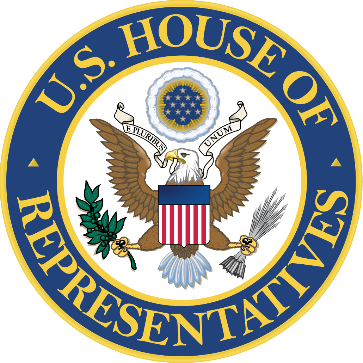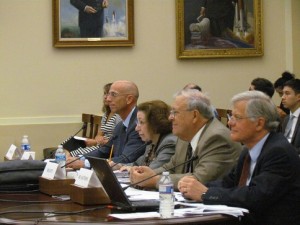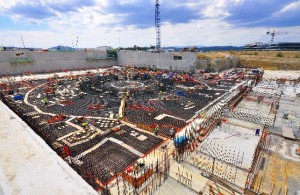
House Science Committee Hearing on Fusion Energy
On Friday, July 11, the Energy Subcommittee of the House of Representatives Committee on Science, Space, and Technology held a hearing on “Fusion Energy: The World’s Most Complex Energy Project.” The major focus of the hearing was on the international ITER project, and the management and budget problems highlighted in a recent GAO report.
 There was one panel of four witnesses testifying at the hearing (links are to their written testimony): Frank Rusco, the Director for Natural Resources and Environment at the GAO; Dr. Pat Dehmer, Deputy Director for Science Programs, DOE; Dr. Robert Iotti, ITER Council Chair; and Dr. Ned Sauthoff, Director, U.S. ITER Project, Oak Ridge National Laboratory. The Hearing Charter, which details the issues to be discussed in the hearing as available here: 7.11.14 House Science Committee Hearing Charter. Sauthoff’s testimony included pictures of the current progress on building ITER, which are featured throughout this post.
There was one panel of four witnesses testifying at the hearing (links are to their written testimony): Frank Rusco, the Director for Natural Resources and Environment at the GAO; Dr. Pat Dehmer, Deputy Director for Science Programs, DOE; Dr. Robert Iotti, ITER Council Chair; and Dr. Ned Sauthoff, Director, U.S. ITER Project, Oak Ridge National Laboratory. The Hearing Charter, which details the issues to be discussed in the hearing as available here: 7.11.14 House Science Committee Hearing Charter. Sauthoff’s testimony included pictures of the current progress on building ITER, which are featured throughout this post.
Here are links to the opening statements from Chairman Lamar Smith, Subcommittee Chairman Cynthia Lummis, Ranking Member Eddie Bernice Johnson, and Subcommittee Ranking Member Eric Swalwell. You can watch the full video from the Science Committee website.
ASP submitted a letter from ASP’s CEO, BGen Steve Cheney, addressed to the Chair and Ranking Members of both the full Science Committee and the Energy Subcommittee, Rep. Lamar Smith (R-TX), Rep Cynthia Lummis (R-WY), Ranking Member Eddie Bernice Johnson (D-TX), and Rep Eric Swalwell (D-CA) in support of further fusion research. We were happy to have the letter entered into the record by Chairman Smith. The letter details ASP’s interest in fusion energy as a key part of America’s next generation of energy. You can download the full letter, and it is also available as a blog post, “Why ASP supports Fusion Research.”
Overall, the hearing featured notable bipartisan support for continued fusion energy research, with bipartisan concern about budget overruns and management problems. Mr. Rusco of the GAO said that the ITER organization was too top-heavy, and that it lacked a project management culture. Both Dr. Iotti and Dr. Sauthoff acknowledged the problems identified in the GAO report, and said that it was getting better. It appeared that Members were satisfied with reports that ITER is aware of the problems identified in the GAO report, and is undertaking an effort to reform itself.
While there was concern about ITER, no Member of the committee expressed concern about the need for investment in fusion. There was important bipartisan support for fusion, with Chairman Smith saying that research into fusion is high risk, high reward, and that “Fusion could solve the problems of climate change.” Subcommittee Ranking Member Swalwell noted that the promise of fusion is “almost limitless.”
Both Republicans and Democrats asked if the budget for fusion research was high enough, given the long term promise. Ranking Member Swalwell asked Dr. Dehmer why the DOE had put an annual cap on funding for ITER at $225 million, and whether that was supported by a bottom-up review. Dehmer replied that it was not, it was a decision made based on overall budget limitations and priorities. As a follow-up, Rep. Swalwell asked whether increasing the US funding for ITER would reduce overall costs and accelerate the project. Both Dr. Iotti and Dr. Sauthoff agreed that accelerating US contributions to ITER would reduce costs overall. Chairman Smith expressed concern about why the Obama Administration was cutting funding for fusion research overall when the promise of fusion was so vast. He asked the panel about what the impacts of the budget cuts have been so far, panelists replied that these cuts make it more difficult to work with the other international partners, who all have longer and more predictable budge cycles.
While most of the questioning surrounded the problems of ITER and the international fusion program, Representatives Veasey (D-TX) and Clark (D-MA) asked about the domestic research program. Dr. Sauthoff said that greater funding for fusion research could allow more runtime and operations on America’s “world class facilities.” Dr. Dehmer said that the current process that the fusion community is undergoing to provide a strategic plan for fusion research will be important in determining what can be done with future funding levels. For more on this process, see ASP’s post “DOE Makes Plans for U.S. Fusion Energy.”
Overall, this was an important hearing that should set the stage for greater interest in Congress in America’s fusion research and development program. The promise of fusion is great, but the challenge is sustaining support over the long term. It is time to get to work.
Further Reading:
Electricity produced from fusion will be safe and clean. It offers hope for an ideal energy source, both in terms of our security and our environment.The question is whether or not the United States will lead in the commercialization of this technology or whether we will depend on others for our energy
Fusion White Paper 2014 – 10 Year Plan for American Energy Security
ASP’s White Paper provides a detailed plan on how to accelerate the development of fusion power. Fusion energy can meet America’s energy needs. Energy from fusion is clean, safe, secure and abundant. However, given current support for fusion, commercializing fusion power remains decades away. …Read more
WHITE PAPER: America’s Energy Choices – 2014
Three years after ASP first released “America’s Energy Choices” in 2011, the U.S. remains stuck in a political stalemate over energy. Even so, the energy choices made years or even decades ago by politicians, businesses, and consumers have led to a revolution in how the U.S. produces energy. The reality of change in America’s energy system is far different from the stagnation of the political debate.
PERSPECTIVE: Five Choices on Energy that We Need to Make
We are in the midst of an energy revolution. There are key choices on energy we must make, but our government has become complacent about the problems of our energy future. This means that we are still coasting on the choices made in response to the crises of the 1970s – we are not responding to the challenges of the 21st Century.
International Progress on Fusion Energy – How American Leadership is Slipping
ASP’s fact sheet, “International Progress on Fusion Energy” outlines the steps other countries are taking in developing fusion energy. Meanwhile, the U.S. is considering budget cuts to its fusion program, which will cause irreparable harm to the development of fusion power.







[…] House Science Committee Hearing on Fusion Energy […]